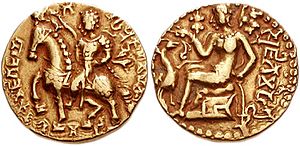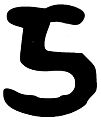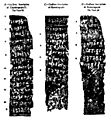Kumaragupta I facts for kids
Quick facts for kids Kumaragupta |
|
|---|---|
| Maharajadhiraja, Parama-bhattaraka, Paramadvaita, Mahendraditya | |
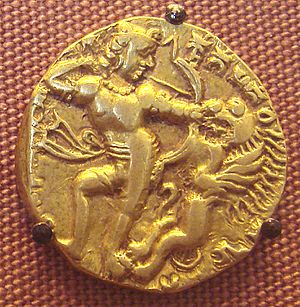
Kumaragupta fighting a lion, as depicted on his gold coin
|
|
| Gupta Emperor | |
| Reign | c. 415 – c. 455 CE |
| Predecessor | Chandragupta II |
| Successor | Skandagupta |
| Spouse | Anantadevi |
| Issue | Skandagupta Purugupta |
| Dynasty | Gupta |
| Father | Chandragupta II |
| Mother | Dhruvadevi |
| Religion | Hinduism |
Kumaragupta I (r. c. 415-455 CE) was an important emperor of the Gupta Empire in ancient India. He was the son of the famous Gupta emperor Chandragupta II and Queen Dhruvadevi. Kumaragupta managed to keep control of the huge empire he inherited. This empire stretched from Gujarat in the west all the way to the Bengal region in the east.
Kumaragupta performed an Ashvamedha sacrifice. This was a special horse sacrifice that ancient kings did to show they were powerful rulers. We don't have many details about his military victories. However, old writings and coins suggest he might have defeated some groups. These include the Aulikaras in central India and the Traikutakas in western India.
Some historical records suggest that Kumaragupta faced challenges in his later years. His successor, Skandagupta, had to "restore the fallen fortunes" of the Gupta family. This might mean there were problems, possibly from groups like the Pushyamitras or the Hunas. But historians are not completely sure if these problems happened during Kumaragupta's rule or right after he died.
Contents
Becoming Emperor
Kumaragupta was the son of Emperor Chandragupta II and Queen Dhruvadevi. His father's last known record is from about 412 CE. Kumaragupta's first record is from about 415 CE. This means he likely became emperor around 415 CE.
Kumaragupta used several important titles. These included Maharajadhiraja (meaning "Great King of Kings"). He also used Parama-bhattaraka and Paramadvaita. He took the special title Mahendraditya, which means "Great Sun" or "Lord of Indra". His coins show different versions of this name, like Shri-Mahendra. Some Buddhist writings mention a king named Shakraditya. This might also have been a title for Kumaragupta.
Kumaragupta's Rule
Kumaragupta took over a very large empire. His father, Chandragupta II, and grandfather, Samudragupta, had expanded it greatly. We don't have much information about his own military wins. But records from his time have been found across a wide area. These places include Madhya Pradesh, Uttar Pradesh, West Bengal, and Bangladesh. Even his son's records were found in Gujarat.
His coins, which show the bird Garuda, were found in western India. Coins with a peacock were found in the Ganges valley. This shows he kept control over the vast lands he inherited. Even if he didn't fight many wars, he must have been a strong ruler. Keeping such a large empire stable for a long time was a big achievement.
There are some hints that Kumaragupta's rule wasn't always peaceful. He worshipped Karttikeya, the god of war. His gold coins also suggest he performed the Ashvamedha ceremony. This ceremony was often done after a king won battles. However, we don't have clear proof of his military victories. So, it's not certain if the ceremony meant he had conquered new lands.
Possible Western Victories
Kumaragupta's coins have been found in areas like modern-day Maharashtra. This region was southwest of the main Gupta lands. A large collection of his silver coins was found in the Satara district. His coins found in southern Gujarat look like those from the Traikutaka dynasty. This suggests that Kumaragupta might have defeated the Traikutakas.
Dashapura Annexation
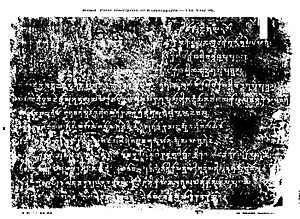
An inscription from 423 CE found in Mandsaur mentions kings from the Aulikara family. Their capital was Dashapura (modern Mandsaur). The inscription talks about silk weavers who moved to Dashapura. Then, it suddenly mentions "while Kumaragupta was ruling the whole earth."
Some historians believe that a king named Bandhu-varman ruled Dashapura under Kumaragupta I. However, other historians think the "Kumaragupta" mentioned might be a later king, Kumaragupta II. Either way, it seems the Dashapura area became part of the Gupta Empire sometime between 424 CE and 473 CE. This could have happened through war or peaceful agreements.
Other Possible Campaigns
Some of Kumaragupta's coins show him as a rhinoceros-slayer. Some experts think this might mean he fought against a king in Kamarupa (modern Assam). Rhinoceroses are common there. Other coins show him as a tiger-slayer. This might suggest he fought in areas south of the Narmada River, where tigers are found. However, some historians don't agree with these ideas, calling them "fanciful."
How the Empire was Run

Records show that Kumaragupta ruled his empire through governors. These governors were called Uparikas and had the title Maharaja ("great king"). They managed different provinces, called Bhuktis. Smaller districts, called vishayas, were managed by district magistrates. These magistrates had a council to help them. This council included:
- The town president or mayor (Nagara-Shreshtin)
- A representative from the merchant guild (Sarthavaha)
- The chief of the artisan guild (Prathama-Kulika)
- The chief of the writers' or scribes' guild (Prathama-Kayastha)
A person named Ghatotkacha-gupta governed the Eran region during Kumaragupta's rule. He was likely a member of the royal family, perhaps Kumaragupta's son or younger brother. Chirata-datta ruled the Pundravardhana province in Bengal under Kumaragupta.
Prithivishena was a key minister for Kumaragupta I. He started as a mantrin (advisor) and later became a mahabaladhikrita (general). His father had also served Kumaragupta's father, Chandragupta II.
Kumaragupta also seems to have had good relations with the Liu Sung emperors of China. Chinese groups visited India, and an Indian envoy was sent to China. This suggests friendly diplomatic ties.
Family Life
Kumaragupta had at least two sons: Skandagupta and Purugupta. Skandagupta became the next king. His records don't mention his mother's name, which was unusual. Purugupta was the son of Queen Anantadevi. Some historians believe Anantadevi was a princess from the Kadamba family. This is because a record mentions a marriage alliance between the Kadambas and Guptas.
A stone record from Skandagupta's time suggests Kumaragupta also married the sister of one of his ministers. Ghatotkacha-gupta, mentioned earlier, was likely a son or younger brother of Kumaragupta.
A Chinese traveler named Xuanzang mentioned a king named Shakraditya as a supporter of the Nalanda monastery. Some scholars think Shakraditya was Kumaragupta I. Xuanzang also mentioned Budhagupta after Shakraditya. However, other records show that Budhagupta was actually the son of Kumaragupta II, not Kumaragupta I.
Religious Beliefs
During Kumaragupta's reign, many different religions thrived. These included Shaivism (worship of Shiva), Vaishnavism (worship of Vishnu), Buddhism, and Jainism. Kumaragupta's silver coins show he was a strong follower of the god Vishnu. He was called parama-bhagavata or bhagavata, meaning "devotee of Vishnu." His coins also feature Vishnu's vehicle, Garuda.
He was also a devotee of the war god Karttikeya (also known as Skanda). His coins show Karttikeya sitting on a peacock. Kumaragupta even named his son Skandagupta after the god. His own name, "Kumara," also seems to be based on another name for the god.
Buddhist writers like Xuanzang (7th century) and Prajnavarman (8th century) said that the famous Buddhist monastery at Nalanda was built by a king named Shakraditya. Modern scholars often connect Shakraditya with Kumaragupta. This is because "Shakra" and "Mahendra" are names for the god Indra. Kumaragupta used the title Mahendraditya. Also, an earlier Chinese traveler, Faxian, didn't mention Nalanda when he visited nearby places. This suggests Nalanda was built after 411 CE, during Kumaragupta's time.
Final Years
The earliest known date for Kumaragupta's son, Skandagupta, is around 455 CE. This means Kumaragupta's rule ended by or before this year. Some historians believe Kumaragupta ruled until 455 CE, based on dates on some of his coins. However, other experts disagree and think his reign ended around 450 CE.
One idea is that Kumaragupta's last years were not peaceful. This is based on two main points:
- The Bhitari inscription says Skandagupta defeated enemies. It states he "re-established the ruined fortunes" of his family when his father died. The enemies might have been the Pushyamitras or the Hunas.
- A statue called the Mankuwar Buddha, dated 448 CE, calls Kumaragupta only "Great King" (Maharaja). This is a lower title than "Great King of Kings" (Maharajadhiraja). This might suggest he faced setbacks in his later years.
However, we can't be completely sure that Kumaragupta faced big troubles. It's possible the lower title was just a mistake. The problems mentioned in the Bhitari inscription might have happened *after* Kumaragupta's death. These troubles could have been a fight over who would become the next king. Another idea is that the problems were caused by an invasion from the Hunas. It's also possible that both things happened: Skandagupta was fighting the Hunas, and then Kumaragupta died, leading to a fight for the throne.
Some historians think Kumaragupta's sons, Skandagupta and Purugupta, might have fought over who would be king. Another idea is that Purugupta, the son of the chief queen, was too young when Kumaragupta died. This allowed Skandagupta, whose mother might have been a junior queen, to become emperor. Skandagupta ruled first, and then Purugupta and his family became the next kings.
Coins of Kumaragupta
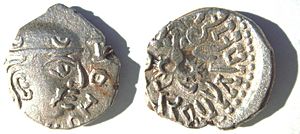
Kumaragupta issued more types of coins than any other Gupta king. A large collection of his coins, found in Bayana, includes 14 different types.
Here are some of the types of coins he issued:
- Archer type: These coins show the king holding a bow and arrow.
- Horseman type: These show the king riding a horse. Some have a goddess feeding a peacock on the back.
- Swordsman type: A new type showing the king holding a sword.
- Lion-slayer type: These coins show the king fighting a lion.
- Tiger-slayer type: Similar to his grandfather's coins, these show the king fighting a tiger.
- Elephant-rider type: Shows the king riding an elephant with an attendant holding an umbrella.
- Elephant-rider lion-slayer type: Similar to the elephant-rider type, but the king is slaying a lion from the elephant.
- Rhinoceros-slayer type: This unique gold coin shows the king on horseback attacking a rhinoceros.
- Ashvamedha-type: Similar to the coins for the horse sacrifice.
- Karttikeya type: Shows the god Karttikeya (also known as Kumara) on a peacock.
- Chhatra-type: Shows the king with an umbrella (chhatra).
- Apratigha-type: Shows a man (possibly the king) with a man and woman on either side.
- Lyrist type: Shows the king sitting and playing a musical instrument like a lute.
- King and queen-type: Shows the king giving flowers to the queen.
Some other coins found have also been linked to Kumaragupta. These coins show a garuda bird and the name Mahendraaditya. However, it's likely these coins were not made by Kumaragupta or any other Gupta ruler.
Inscriptions
We have at least 18 inscriptions from Kumaragupta's time. These inscriptions were mostly made by private citizens, not the royal family. Most of them talk about religious matters. But they are very helpful for historians. They provide information about the Gupta kings, dates, locations, and names of royal officers. The first Gupta inscriptions found in the Bengal region are from Kumaragupta's reign.
{{Wide image|Kumaragupta Tumain Inscription..jpg|880px|Tumain inscription of Kumāragupta, found in Madhya Pradesh. Dated 436 CE.]]

| Find spot | Image | Type | Period | Source |
|---|---|---|---|---|
| Bilsad (or Bilsarh), Etah district |
|
Stone pillar | Gupta Era 96 (c. 415 CE) | |
| Gadhwa (or Ghadwa), Allahabad district |
|
Stone | Gupta Era 98 (c. 417 CE) | |
| Gadhwa (or Ghadwa), Allahabad district | Stone | Undated | ||
| Gadhwa (or Ghadwa), Allahabad district | Stone | Undated | ||
| Udayagiri |
|
Cave | Gupta Era 106 (c. 425 CE) | |
| Mathura | Jain idol | Gupta Era 113 (c. 432 CE) | ||
| Dhanaidaha, Bangladesh | Copper plate | Gupta Era 113 (c. 432 CE) | ||
| Mathura |
|
Buddha image | Gupta Era 115 (c. 434 CE) | |
| Tumain |
|
Stone | Gupta Era 117 (c. 436 CE) | |
| Karamdanda, Uttar Pradesh |
|
Stone linga | Gupta Era 117 (c. 436 CE) | |
| Kalaikuri-Sultanpur, Bangladesh | Copper plate | Gupta Era 120 (c. 439 CE) | ||
| Damodarpur near Phulbari, Bangladesh | Copper plate | Gupta Era 124 (c. 443 CE) | ||
| Mathura | Broken idol | Gupta Era 125 (c. 444 CE) | ||
| Damodarpur | Copper plate | Gupta Era 128 (c. 447 CE) | ||
| Baigram (or Boigram), Bangladesh | Copper plate | Gupta Era 128 (c. 447 CE) | ||
| Man Kuwar (or Mankuwar), Uttar Pradesh |
|
Buddha image | Gupta Era 129 (c. 448 CE) | |
| Sanchi | Stone | Gupta Era 131 (c. 450 CE) | ||
| Mathura | Buddha image | Gupta Era 135 (c. 454 CE) |
An inscription on a statue of a yaksha from Mathura in Kumaragupta's reign is dated to 432 CE. Also, a pedestal (without a king's name, but likely from his time) is dated to 442 CE.
Images for kids
See also
 In Spanish: Kumaragupta I para niños
In Spanish: Kumaragupta I para niños





